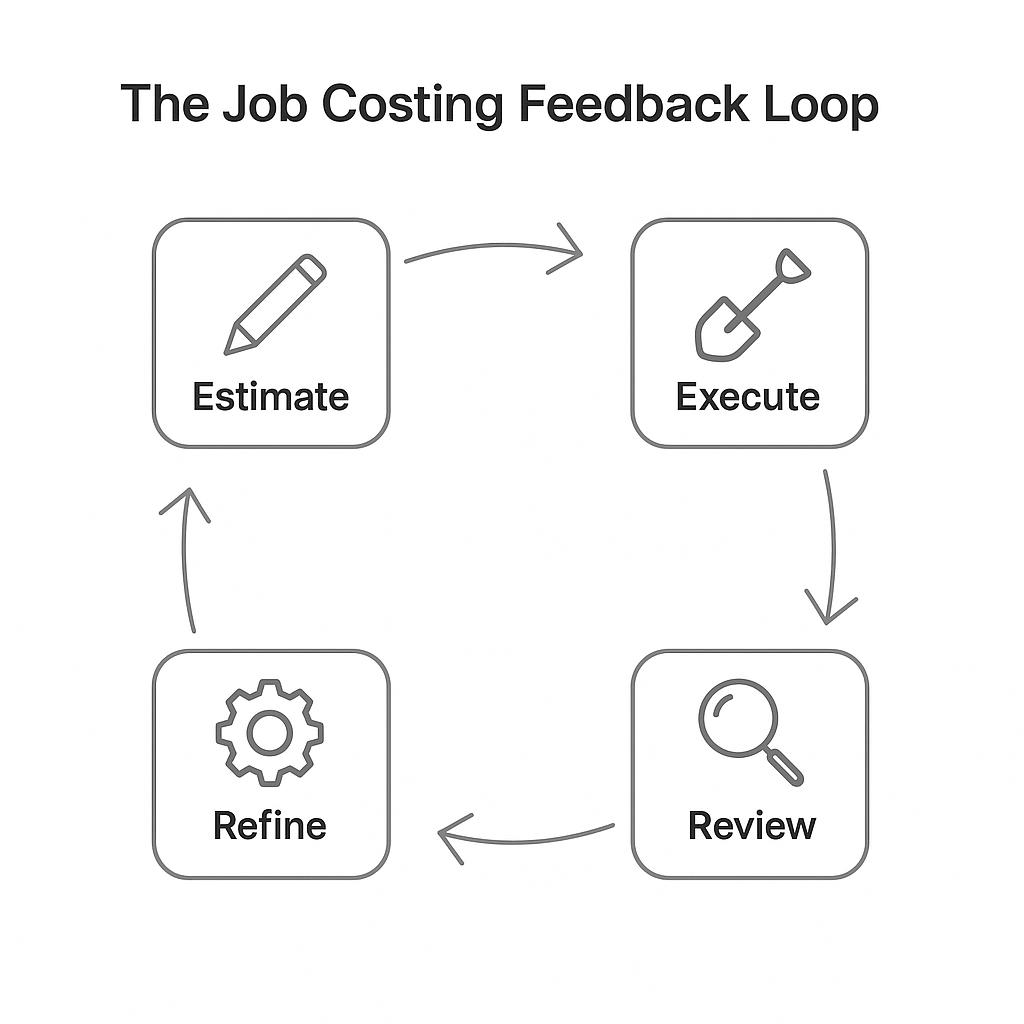How does your business handle landscape pricing? Many landscapers would answer that they price jobs using educated guesses or intuition based on years of job experience. What they might not know is that this approach often leaves money on the table. Without hard data backing up your estimates, you can’t say for sure that you’re charging clients exactly what your work is actually worth.
Job costing analysis takes that guesswork and transforms it into a consistent, data-driven pricing system. When done consistently, job cost analysis reveals the true cost of completing a job, including labor, materials, and equipment, while allowing landscapers to fine-tune their pricing models.
In this article, we’ll explore how job cost analysis helps landscapers set smarter prices, uncover inefficiencies, and adjust pricing and production rates based on real, historical information. Let’s get started!
The Role of Job Costing
Job costing is the practice of taking your estimated hours, materials, and expenses for jobs and comparing them with your actual hours, materials, and expenses. By comparing this data, you’ll discover where your estimates were accurate, and where variances occur in labor hours, materials used, or equipment usage. You might even discover that the job included materials that you forgot to include in the estimate!
Job costing can be broken down into three major components.
- Labor: Comparing estimated labor hours to the actual hours worked shows whether the job required more or less labor than you planned, a key factor for determining accurate pricing.
- Materials: Comparing your estimated material cost to what you actually spent shows whether your crew used more or fewer materials than expected, helping you pinpoint cost overruns or areas where future estimates need adjustment.
- Equipment: Comparing your estimated equipment usage to the actual days or hours used reveals whether the job relied on equipment longer than planned, which impacts overall profitability of a job.
Ultimately, the goal of job costing is to use real job data to identify mistakes, learn from them, and adjust future estimates accordingly. This data and analysis forms the foundation for smarter long-term landscape pricing strategies. You can’t improve what you can’t measure, and job costing measures everything that matters.
How Job Costing Impacts Landscape Pricing
Accurate pricing depends on understanding production rates, or how much labor, material, and equipment it takes to do this kind of work. If your production rates haven’t been validated in a while, your landscape pricing model can drift from actual field performance, making it nearly impossible to guarantee accurate estimates. Whenever you get something wrong on the estimate, it comes right out of your business’s profit, kneecapping your ability to make any money, upgrade your equipment, or compensate your team for their hard work.
By using job costing analysis to compare estimated to actual labor hours, material, and equipment, you can identify which services take longer or less time than you have been calculating in your estimates and adjust accordingly. Job costing can also help uncover hidden inefficiencies such as underestimated setup times, untracked material use, or crew performance differences.
Identifying repeated patterns across multiple jobs gives you reliable benchmarks you can use to update and refine your production rates, helping you price similar work with far more confidence. Job costing isn’t just about catching mistakes, it’s about creating a roadmap for better business decisions, setting your company up for long-term success.
Turning Job Costing Data Into Pricing Insights
Job costing doesn’t need to be complicated. At its core, it’s just keeping track of what you spent on labor, materials, and equipment for each job and comparing those numbers to what you initially estimated. Once you have that information laid out in front of you, patterns start jumping out. You’ll start to see which services consistently make money and which services are always costing you money (that’s where your estimates need to be adjusted). From there, it’s simple enough to tweak your production rates or update an estimating template so your pricing lines up with real-world performance.
Just remember: every completed job should be able to teach you something if you take the time to review the numbers. As long as you’re doing a good job of tracking labor hours and saving your receipts, you’re already job costing! And, you’ll have everything you need to price your next job even more accurately.
Continuous Improvement Through Feedback Loops
Job costing is a simple cycle. You start by estimating a job with the best information you have (even if some of it is gut feel). Once you win the job, you track your crew’s hours and the materials you buy. When the job is done, you compare what you estimated to what actually happened. That comparison gives you clear insights you can use to tighten up your numbers next time. Over time, this cycle sharpens both estimating accuracy and crew productivity.

Tracking trends across months or over seasons can highlight consistent problem areas that might have gone unnoticed before, like underbidding certain service types or recurring material shortages. The goal of this landscape pricing cycle isn’t perfection on the first try, but to get better with every job you complete. When applied consistently, this feedback loop results in more predictable profit margins and more competitive bids.
Building a Data-Driven Pricing Model
When executed correctly, landscape pricing evolves from a best guess into a consistent formula supported by data. Job costing allows you to identify your most profitable services and ideal customer profiles. Over time, consistent analysis produces enough data to support long-term pricing strategies and growth planning.
Companies that use this data-driven model can be confident in the estimates they provide, knowing those prices are based on proven cost performance instead of a reaction to market pressure. This approach also fosters transparency across teams by creating a factual basis for pricing shared across estimators, crew leaders, and owners. When your pricing reflects reality, every part of your business, from sales to production to accounting, works in sync.
Smart, Simple Landscape Pricing With SynkedUP
Job costing analysis is the foundation of data-driven landscape pricing, bridging the gap between what you think a job costs and what it actually costs. Landscapers who consistently review and refine their job costing data gain an undeniable edge: better estimates, stronger margins, and perhaps most importantly, greater confidence that they are giving their customers the best price every time.
When it comes to job costing, the hard part isn’t the act of comparing estimated vs actual hours and expenses, it’s the daily real-time collection of that information, and compiling it into real-time reports you can share with your team. But before you get too overwhelmed, rest assured that SynkedUP has you covered!
SynkedUP is a landscape pricing software built by contractors, for contractors. We know firsthand how accurate production rates and solid pricing can impact job profitability. That’s why we’re so excited to provide users with the tools they need to estimate, win, and track jobs quickly, accurately, and confidently. We even offer a free job costing spreadsheet and a course on job pricing to help you get started!
But it doesn’t stop there. SynkedUP’s software leverages real job data to track work, provide accurate production rates, and report on progress and expenses in real time. Our estimating tool lets users plug your company’s expenses into our drag-and-drop interface to quickly and easily create data-driven estimates. Those estimates are then used to automatically generate proposals, which you can then send to customers directly from the software, saving you time and energy without sacrificing precision or attention to detail.
To learn more about SynkedUP and the ways it can revolutionize your business, contact us for a demo today!








